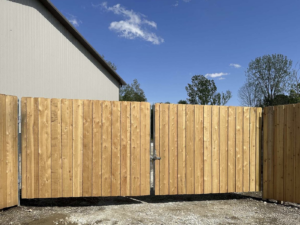A fence can add value to a home, improve privacy, and keep children and pets safe. Whether it’s a classic zigzag post-and-rail or an elaborate molded vinyl style, there are a variety of fencing materials to suit any property.
Cedar, redwood, and pine are popular wood options for their durability and natural resistance to rot and insects. Pine is also an economical choice, particularly when pressure-treated. Click Charlotte Fence Company to learn more.

Fences have long played an important role in enhancing home and business security. They provide a physical barrier that deters unwanted intruders, and can help to keep children and pets safe from wandering off the property. Security fences are also often used to protect vehicles and outdoor equipment from theft or vandalism. There are many options for security fencing, including materials, height and design. A solid fence with no gaps is generally more effective at deterring intruders, while a taller fence can be harder to scale. Additionally, security fences can include features like anti-climb elements and sensors to detect movement within the perimeter.
A fence can be a powerful tool in protecting people from harm, but it is important to understand how it works and what its limitations are. A fence can help to reduce the risk of burglary, robbery and other property crimes, but it is not a substitute for police or other crime-fighting measures.
In addition to providing a physical barrier, a fence can also serve as an important visual deterrent. Fences can be painted or designed to match the aesthetic of a building, making them an attractive addition to any residential or commercial area. However, it is important to choose a material that will be resistant to rust and corrosion, as well as being easy to maintain.
One common type of security fence is an electric fence, which uses electricity to deter unauthorized entry into a property. These fences consist of wires connected to an energizer that emits high-voltage pulses. If an animal or person touches the fence and the ground during these pulses, they will receive an electric shock. These shocks can range from mild to lethal. Electric fences are commonly used in agriculture, non-human animal control and for high-security areas.
Fences can have significant impacts on natural and social ecosystems, and must be carefully considered when designing and installing them. They are often proposed as a “technological fix” for a purportedly straightforward biological problem, such as livestock-wildlife conflicts or forage competition, but they can have complex impacts on humans and wildlife that are driven by multiple ecological, economic and social forces.
Privacy
A fence can help protect people from harm by blocking views of private property, keeping unwanted visitors out, and enhancing security. It can also be used to delineate boundaries and create a visual focal point in gardens or backyards. However, it is important to consider other factors when choosing a fence design, especially if it will be located in an urban environment where crime is higher.
The privacy features of a fence are determined by several factors, including material, height, and design. Generally, fences made of wood are the most popular for providing privacy because they offer a natural look and are dense enough to block the view of neighbors or passersby. They are also relatively affordable and can be stained or painted to match the aesthetic of a home. Vinyl fences are another popular option for privacy because they are low-maintenance and can withstand harsh weather conditions.
Privacy fences are often taller than other types of fences, which is another factor that contributes to their privacy benefits. However, it is important to note that the height of a fence doesn’t automatically guarantee privacy, as it depends on the design and how tightly the boards or panels are set together. Wide gaps, even in a high fence, can still provide minimal privacy.
Although fences are often considered to be a positive addition to a landscape, some researchers have found that they can have negative impacts on wildlife and ecosystems. For example, fences can trap wildlife and limit their movement, which may result in disease transmission and starvation. Furthermore, they can prevent animals from obtaining food or water from other areas. Fences can also impede the survival of endangered species by blocking access to crucial habitats and preventing gene rescue in case of disasters.
Privacy fences can be made from various materials, such as wood, vinyl or composite materials. The type of fence you choose will depend on your budget, maintenance requirements, and desired level of privacy. It is also important to consider the location of the fence and how it will fit into the overall aesthetic of your backyard or garden. Wood fences are popular for their natural appearance, but they can deteriorate over time if not properly maintained. Vinyl and composite fences require less maintenance but may still need to be cleaned on occasion to avoid fading or cracking.
Durability
A fence is meant to protect people from harm and the things that they love, but it isn’t indestructible. Over time, even the most durable fences can take hits they can’t recover from.
That’s why it is important to consider your property’s needs and environmental conditions when choosing the best fence materials. Durability features such as impact resistance, rust and corrosion prevention, rot and insect resistance, and flexibility are key characteristics that set top-performing fence materials apart from their less-durable counterparts.
Wood fences, for example, can be damaged by moisture which can reduce their longevity and affect the integrity of the structure. However, if the fence is treated with a water-repellent stain or sealant, this problem can be avoided. Similarly, metal fences are susceptible to rust and corrosion. They can be protected against this problem by applying a rust-inhibiting treatment, or by galvanizing the entire fence.
The durability of a fence is also determined by its ability to bend under pressure without breaking. This is where vinyl fencing shines, as it has the flexibility to absorb shocks and impacts from wind or other forces while still returning to its original shape. Likewise, aluminum fences are more likely to bend than break in the event of extreme force.
If you want your fence to last for decades, then it’s essential to invest in quality materials and professional installation. Using a fence post straightener or come-along winch to pull a bent fence back into position will improve its longevity and ensure it is structurally sound.
A well-maintained fence can be a beautiful addition to your property for many years, providing security, privacy, and aesthetic value. Regular maintenance practices like cleaning with mildew remover, applying a UV protectant, and touch-up paint will prolong the life of your fence and keep it looking beautiful. It is important to follow manufacturer recommendations as some treatments and cleaning methods may not be compatible with certain types of fence materials.
Aesthetics
A fence’s aesthetic features play a crucial role in shaping the overall landscape of a residential or commercial outdoor setting. From the color of the fence to its design, it is essential to align the fence’s appearance with its surroundings. By doing so, it becomes more than just a boundary but an element of the garden or outdoor landscaping.
From the materials used to the decorative elements, a fence is an expression of the homeowner’s personal style. Natural wood fences, for example, complement both rustic cottage-style homes and modern architectural designs. They also age gracefully, gaining a unique character as they weather over time.
Conversely, metal fences offer a sleek, minimalist look, perfect for contemporary outdoor settings. Their sleek lines also contribute to a sense of privacy and security, making them a popular choice for homeowners looking for a combination of style and functionality.
Additionally, a fence can be adorned with various plant species like Ivy or Creeping Fig to create a living fabric that changes with the seasons, adding another dimension of visual appeal. Incorporating these plants into your fence also gives you the added benefit of enjoying their colorful flowers or lush leaves throughout the year.
Moreover, decorative elements like finials and lattice work provide an elegant aesthetic, perfect for those seeking a more formal touch to their fencing. Using these decorative elements can help your fence stand out from the crowd and become a focal point of your landscape.
Fencing offers a host of aesthetic possibilities that go beyond its functional purposes and can be used to enhance people’s lives. Whether it’s providing privacy or fostering community, a well-designed fence is a powerful tool that can elevate the visual appeal of any space. Learn how to make your fence stand out from the crowd and leave a lasting impression on visitors with these tips.








